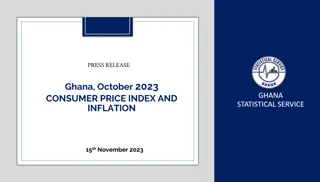
Electrolyte Disturbances and Fluid Balance in the Body
Learn about electrolyte disturbances and the importance of fluid balance in the human body. Explore the factors influencing body fluid composition, the significance of intracellular and extracellular fluid compartments, normal input and output of fluids, common electrolyte imbalances like hyponatremia and hypernatremia, along with their symptoms, diagnostic evaluation, and management strategies.
Download Presentation

Please find below an Image/Link to download the presentation.
The content on the website is provided AS IS for your information and personal use only. It may not be sold, licensed, or shared on other websites without obtaining consent from the author. If you encounter any issues during the download, it is possible that the publisher has removed the file from their server.
You are allowed to download the files provided on this website for personal or commercial use, subject to the condition that they are used lawfully. All files are the property of their respective owners.
The content on the website is provided AS IS for your information and personal use only. It may not be sold, licensed, or shared on other websites without obtaining consent from the author.
E N D
Presentation Transcript
Introduction . Body fluid:- Approximately 60% of adult weight is composed of fluid Factors that influence the amount of body fluids 1. - Age : Younger people have a high percentage of body fluid than do older people 2. -Gender:- Men have proportionally more body fluid than do women Body fat 3. - Obese people have less fluid than thin people Body fluid is located in two compartments -40% in intracellular , 20% extracellular 1. The intracellular fluid: - Approximately two-thirds of body fluid is in intracellular fluid compartment 2. The Extracellular fluid - Approximately one-third of body fluid is extracellular. Extracellular fluid has two main subdivision 1 Intravascular 2. Extravascular (interstitial space) -Note / Body fluid normally shift between two compartments in order to maintain an equilibrium
normal input = output -hydration fluid over load = input ---- output -dehydration fluid loss= input ----- output Routes of fluid loses 1. -kidneys (1-2L) 2. -skin (600 ML ) 3. -lung INSP & EXP. 4. -Gastrointestinal ( 100 200 ML ) Laboratory tests evaluation 1. Blood Urea Nitrogen (BUN) 2. Creatinine 3. Hematocrit Electrolytes
Na (135-145) Normal rang Sodium deficit (hyponatremia) . Definition na 135 . Contributing factors . 1. Renal disease . 2. Gain water via administration of fluids . 3. Excessive water supplements (tube feeding) . 4. Compulsive water drinking (psychogenic polydipsia) . Signs and symptoms / Anorexia, Nausea, vomiting, headache, lethargy. confusion, muscle cramps. Poor elastic skin turgor, dry mouth hypotension.(common ) . Diagnostic Evaluation/ Serum electrolyte . medical management . 1. Sodium replacement (mouth, NG tube, Intravenous) 2. .Water restriction . 3. Intake and output (1&0) and daily weight . 4. Monitor serum sodium closely . 5. Encourage fluids and foods with high sodium content
Sodium Excess (Hypernatremia) -Definition . Na 145 contributing factors . 1. Loss of water (watery diarrhea) and gain of sodium (drowning) 2. Fluid deprivation in an unconscious patient 3. Diabetes insipidus 4. Heat stroke .Signs and symptoms /Dry mouth, thirsty,, restlessness, fatigue, general weakness, disorientation, hallucination, and brain damage, BP Diagnostic Evaluation / Serum electrolyte . medical management . 1. Isotonic non-saline solution . 2. Monitor the changes in behavior . 3. Intake and output (1&0) and daily Weight . 4. Monitor serum sodium . 5. Offering fluid at regular time for diabetes insipidus
Potassium (3.5-5.5) Potassium deficit (Hypokalemia) Definition K 3.5 Contributing factors . 1. Vomiting and diarrhea . 2. Gastric suction . 3. Uses of diuretics . 4. Decrease dietary intake . Signs and symptoms Fatigue, anorexia, nausea, vomiting, muscle weakness, leg cramps, paresthesia, cardiac dysrhythmias (Flattened T waves, prominent of U waves and ST depression) Diagnostic Evaluation ECG, serum electrolyte. . medical management 1. -Oral or IV replacement therapy 2. -Monitor ECG for change 3. -Dietary supplement 4. - Intake and output (1&0) 5. - Monitor serum potassium closely
Potassium Excess (hyperkalemia) Definition K 5.5 Contributing factors . 1. Renal Failure (decrease renal excretion) . 2. Rapid intravenous administration of potassium (treatment of hypokalemia) . 3. Hemolytic anemia (Excessive destruction of RBC) 4. Medications (heparin, captopril, etc...) Signs and symptoms Fatigue, anorexia, nausea, vomiting, muscle weakness cardiac dysrhythmias (Tall tented T waves and ST depression) Diagnostic Evaluation -ECG - serum electrolyte . medical management . 1. Administration of regular insulin and dextrose . 2. Peritoneal or hemodialysis . 3. Monitor ECG for changes . 4. Intake and output (I&O) . 5. Monitor serum potassium
Calcium ca (8.5-10.5) ca deficit (Hypocalcemia) -Definition Ca 8.5 - Contributing factors . 1. Hypoparathyroidism . 2. Surgical removal of parathyroid gland . 3. Vitamin D deficiency . 4. Pancreatitis Signs and symptoms .Positive Trousseau's Sign. . Positive Chvostek's Sign .Tetany .Numbness and tingling of fingers and toes Diagnostic Evaluation Serum ca . medical management . 1. Administration of calcium gluconate . 2. Vitamin D therapy . 3. Seizure precautions .Intake and output (1&0) . 4. Monitor serum calcium closely
Calcium Excess (Hypercalcemia) . Definition 10.5 . Contributing factors 1. -Hyperparathyroidism . 2. - Over use of calcium supplement | 3. -Vitamin D excess signs and symptoms 4. -Renal colic -Renal calculi . 5. -Hypercalcemia crisis Signs and symptoms : stomach upset, nausea, vomiting and constipation. Bones and musclesbone pain and muscle weakness Diagnostic Evaluation Serum ca medical management . 1. - Treat the underlying cause 2. -Increase fluid intake . 3. - Normal saline IV administration 4. -Calcitonin (IM or S.C. hypocalcemia) 5. -Corticosteroids (decrease shifting of calcium















